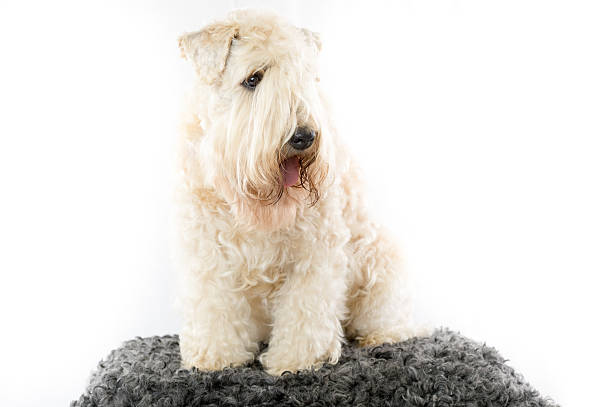Irish Soft Coated Wheaten Terrier

Breed History:
The Irish Soft Coated Wheaten Terrier hails from Ireland, where it was developed over 200 years ago as a versatile farm dog. Bred to herd livestock, guard property, and hunt vermin, it was the working companion of poor Irish farmers who needed an all-around capable and low-maintenance dog.
This breed shares ancestry with other Irish terriers, such as the Kerry Blue and Irish Terrier, but was distinguished by its soft, wheaten-colored coat. Despite its long presence in Ireland, it was not officially recognised until 1937 by the Irish Kennel Club and much later by the American Kennel Club in 1973. Today, the Wheaten is known for its cheerful temperament and charming looks.
|
Gender |
Height |
Weight |
|
Male |
46-48 cm |
16-18 kg |
|
Female |
43-46 cm |
14-16 kg |
Size – Medium
Life Expectancy: 12–15 years

Breed Appearance:
The Irish Soft Coated Wheaten Terrier is compact, well-balanced, and squarely built, with a soft, silky coat that flows in gentle waves. The distinctive wheaten-colored fur ranges from pale beige to warm gold and gives the breed a fluffy, friendly look.
It has a rectangular head with a strong muzzle, dark, expressive eyes, and small, forward-folding ears. The coat should never be harsh or curly, and its unique texture and colour develop fully as the dog matures. The Wheaten’s overall expression is lively and endearing.
Breed Type – Terrier/Companion:
Although originally a working farm dog, the Wheaten has become a popular family companion. It retains much of its terrier independence and alertness, but it is generally less feisty and more sociable than other terrier breeds.
This breed is known for its affectionate, playful, and loyal nature, often forming close bonds with all family members. It gets along well with children and, when socialised properly, other pets. The Wheaten is alert but not aggressive, making it more of a friendly watchdog than a guard dog.

Training:
The Wheaten is intelligent and eager to please, though it can sometimes show a stubborn streak typical of terriers. Consistent, positive reinforcement-based training works best, using treats, praise, and variety to keep it engaged.
Early socialisation and obedience training are recommended to manage potential willfulness and to help the dog become a confident, well-mannered adult. This breed is quite responsive to training but benefits from firm yet gentle leadership.
Health & Care:
The Irish Soft Coated Wheaten Terrier is a generally healthy breed but can be prone to a few hereditary conditions, including:
-
Protein-losing enteropathy (PLE)
-
Protein-losing nephropathy (PLN)
-
Renal dysplasia
-
Addison’s disease
-
Hip dysplasia
Health testing and regular checkups are important. A high-quality diet, appropriate exercise, and preventive care help maintain the breed’s overall health.

Living Conditions:
The Wheaten adapts well to both city and rural environments, provided it receives daily exercise and interaction. It does well in apartments if properly exercised but truly thrives in homes where it can be part of daily life.
This breed dislikes being left alone for long periods and can develop separation anxiety if neglected. A securely fenced yard is beneficial, as the Wheaten can be an enthusiastic digger and chaser.
Exercise:
Moderately active, the Wheaten requires at least 30 to 60 minutes of daily exercise. This can include:
-
Walks and play sessions
-
Backyard games like fetch
-
Dog sports such as agility or obedience
-
Interactive toys for mental enrichment
While not as high-energy as some terriers, the Wheaten enjoys activity and will become restless or barky without sufficient stimulation.
Grooming:
The Wheaten’s soft, non-shedding coat is one of its defining features, but it requires regular grooming to prevent mats and tangles:
-
Brush thoroughly 2–3 times per week
-
Professional grooming or trimming every 6–8 weeks
-
Bathe monthly or as needed
-
Clean ears and brush teeth regularly
-
Trim nails routinely
Despite being low-shedding, its coat can trap dirt and debris, requiring consistent upkeep.

Advantages:
-
Friendly, playful, and affectionate with families
-
Less aggressive than many terrier breeds
-
Non-shedding coat; good for mild allergy sufferers
-
Adaptable to various living environments
-
Intelligent and trainable with consistent effort
-
Good with children and sociable with other pets when socialised
Disadvantages:
-
Requires frequent grooming and coat maintenance
-
Prone to certain genetic health issues (PLE/PLN)
-
Can be stubborn or willful if training is inconsistent
-
May develop separation anxiety if left alone too long
-
Needs regular exercise to avoid boredom-related behaviours
-
May chase small animals due to terrier instincts

